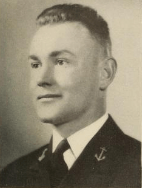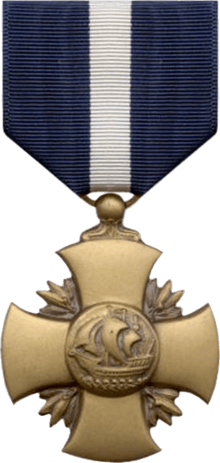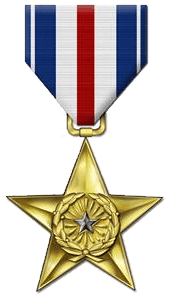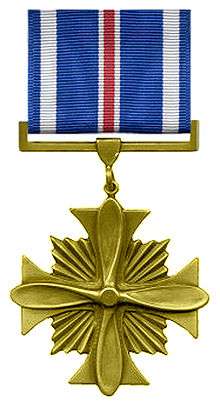Albert O. Vorse Jr.
Albert Ogden "Scoop" Vorse Jr. (August 9, 1914 – October 27, 1979) was an accomplished United States Navy aviator and flying ace of World War II who participated in some of the most prominent actions of the Pacific theater, including the Battle of the Coral Sea and the Guadalcanal Campaign. Vorse served in early fighter squadrons with legendary figures like Butch O'Hare and Jimmy Thach. Rising in rank throughout the war, he would act as Executive Officer and Operations Officer in different squadrons before being given command of his own squadron, VF-80, the eponymous Vorse's Vipers. Vorse ended the war as commander of Air Group 80 and ultimately achieved rear admiral rank before his retirement in 1959.
Albert Ogden Vorse Jr. | |
|---|---|
 | |
| Nickname(s) | "Scoop" |
| Born | August 9, 1914 Philadelphia, United States |
| Died | October 27, 1979 (aged 65) |
| Allegiance | United States |
| Service/ | United States Navy |
| Years of service | 1937–1959 |
| Rank | Rear Admiral |
| Commands held | VF-80 Air Group 80 |
| Battles/wars | World War II |
| Awards | Navy Cross Silver Star Distinguished Flying Cross (2) |
Early life and career

Vorse was born 9 August 1914 to Albert Ogden Vorse and Emma Yarnall Vorse. He was the eldest of three children, having both a brother, Frank Miller Vorse, and later a sister, Mary Ellen Vorse.[1] Albert O. Vorse Sr. graduated from Yale Forest School in 1910 and worked as a forester for the landscape architecture firm Peters, Byrne and Company around the time of Albert Jr.'s birth.[2] Albert Vorse Jr. entered the Phillips Academy Andover in 1929. While attending the prestigious prep. school, Vorse was on the wrestling, swimming, football and track teams.[3] He graduated as a senior in 1933 and went on to the United States Naval Academy at Annapolis, Maryland. "Scoop" is again portrayed in football gear in his 'Lucky Bag' senior yearbook.[4]
Upon graduation from the U.S. Naval Academy in 1937, Ensign Vorse reported for first duty to Naval Base San Pedro, where he was assigned to USS Astoria.[5] He stayed with the ship for a couple years, serving as an officer when it returned the ashes of former Japanese Ambassador Hirosi Saito to his country in 1939.[6] 15 March 1940 he was detached from the ship and sent to Naval Air Base Pensacola for aerial training.[7] This same year his wife would give birth to their first son on 9 December 1940.[8]
World War II
VF-3
Vorse was attached to the aircraft carrier Saratoga's VF-3 fighter squadron in January 1941.[9] VF-3's division leaders were men like Commanding Officer Jimmy Thach, credited with developing the eponymous Thach Weave, and Donald Lovelace, for whom the destroyer escort USS Lovelace was later named. Vorse was a section leader in the squadron. VF-3 bore an imposing pedigree: it was the first carrier-trained unit (then called VF-2) and among the first to employ dive bombing tactics (as VB-2B).[10]
Though his stint with VF-3 was a short one, he did see aerial combat with the unit and was awarded the Distinguished Flying Cross for actions performed on 20 February 1942. On that day, several Japanese Kawanishi H6K flying boats had followed the aircraft carrier Lexington and vectored Japanese carrier bombers and Mitsubishi G4M land attack planes to her coordinates. Thach's 1st Division splashed some of these snoopers but ran through its fuel reserves and was forced to land back aboard Lexington. Lovejoy's 2nd Division (of which Vorse was a section leader) went up as relief, but had yet to meet the enemy by the time Gayler's 3rd Division—launched early on a hunch—went skyward. What transpired next would give the Navy its first ace of World War II as well as its first Medal of Honor recipient for the war.
The first group of the Imperial Japanese Navy's 4th kokutai showed up on the scene and was rapidly intercepted by Lexington's CAP. The men of VF-3's 3rd Division were the first to intercept this initial wave of bombers, and each section of Gayler's division was credited at least one bomber downed. Meanwhile, as 2nd Division was en route to landing, they were re-routed for intercept to assist 3rd Division. They arrived just in time to harry the disorganized bombers. Vorse and four other pilots in 2nd Division finished the Japanese attack, earning one credit each before they moved on to the attack planes that were retreating. Refueled and ready to enter the arena once more, Thach's 1st Division—sans a reserve crew of Butch O'Hare and Duff Dufilho—took to the skies just as a gas-depleted 2nd Division was finally landing aboard Lexington. The 1st Division worked over the land planes and even had an assist by a Lexington Douglas SBD Dauntless from VS-2, which finished off the Japanese land planes and forced the last air-worthy bomber to retreat.
_on_5_March_1942.jpg)
A second division of the 4th kokutai, split up from its sister division in order to better find Lexington in the overcast weather, would be badly thrashed by O'Hare and Dufilho. The two pilots were the only fighters available to intercept the bombers in time given available resources. With "Duff" Dufilho's guns jammed, it would fall to O'Hare to single-handedly scatter the enemy. O'Hare performed the feat, earning himself five kills and propelling him into the history books as the Navy's first Medal of Honor recipient and ace of the war.
VF-2
After Saratoga was torpedoed on 11 January 1942, the aircraft carrier was forced to return to Pearl Harbor for repairs. Soon to arrive at Pearl Harbor for refitting and redeployment was USS Lexington, which incidentally needed experienced aviators to fill out the ranks of its much-depleted VF-2 squadron. The two had already traded air groups in the wake of Saratoga's battle damage so there was some familiarity between the carriers. Since Saratoga's repairs would take months to finish and the Navy was aware of trouble brewing in the area of the Coral Sea, 12 April 1942 Jimmy Thach loaned a number of VF-3 pilots to VF-2 CO Paul H. Ramsey. Vorse was among those sent over to Lexington and would remain with VF-2 until 16 June 1942, mere weeks before its disestablishment.
The Battle of the Coral Sea would begin seemingly inauspiciously for "Scoop" Vorse. Rotten weather caused him and his wingmen to lose track of the VT-2 Douglas TBD Devastators they were charged with shepherding to the target area. With no hope of reconnecting with the outbound torpedo bombers, his section was forced to head back to Lexington. The change in plans wound up assisting in the defense of Task Force 17, however, when Vorse, returning to the formation of ships, broke through the clouds and into the flak-filled skies above Lexington and Yorktown. Almost immediately he spotted a lone Aichi D3A Val dive bomber making a run on Yorktown. Vorse zeroed in from above and followed the Val into the beginnings of its dive, shearing the enemy aircraft's wing from its fuselage with a hail of bullets. Even with this last-second effort, the Japanese bomb splashed dangerously close to Yorktown, exploding only a few hundred feet from port.[10]:Ch. 12[11]
Return to VF-3
After Coral Sea, the loaned pilots returned to VF-3. However, with Lexington sunk and VF-2 attached to Saratoga, VF-3 was now effectively homeless. In the interim it operated out of Pearl as a training unit. Jimmy Thach passed command to Butch O'Hare on 24 June 1942, making him CO, and O'Hare subsequently appointed Vorse as his Executive Officer (XO). Vorse wouldn't stay put more than a couple of weeks, however. The Navy was in the midst of a major reshuffling of fighter squadrons, including a move from twenty-seven to thirty-six plane squadrons as a standard complement. In the post-Midway milieu, fighter-starved air groups were actively recruiting from squadrons like O'Hare's VF-3. Champing at the bit to get back out to sea, Vorse took Capt. James M. Shoemaker up on an offer to join VF-6. Only 6 July 1942 Vorse was transferred; nine days later VF-6 would depart with USS Enterprise, a part of Task Force 16 under the command of Admiral Kinkaid.[12]
VF-6
The freshly staffed VF-6 "Shooting Stars" would see action and see it fast. Enterprise steamed along with Saratoga and Wasp as part of Task Force 61 under Vice Admiral Frank Jack Fletcher. It would support the U.S. Navy's first true counter-offensive and amphibious assault in the Pacific Ocean Theater, inaugurating the fighting at Guadalcanal on 7 August 1942. TF 61 arrived at Guadalcanal undetected and ahead of Japanese expectations. As a result, Japanese materiel such as planes for the newly constructed runways had yet to arrive, and Japanese defenses were neither manned nor even fully operational. When Saratoga and Enterprise's air groups began their runs on Red Beach in the pre-dawn hours they were virtually unopposed. The Japanese air response was coming in fast, though: the 5th Air Attack Force scrapped plans to attack the Allied airfield at Rabi and instead launched straightaway for Guadalcanal. Veteran Japanese aces like Hiroyoshi Nishizawa and Saburō Sakai of the Tainan Air Group would soon bear down on Vorse and company.
As leader of division Red 5 of VF-6, Vorse regularly flew CAP and had a number of memorable sorties during the month of August. In fact the very first day of combat, 7 August, he would launch three times: initially to run SCAP (air patrol for the transport screen) at 0642 hours, then CAP at 1015, and finally an attack flight sent up at around 1320 in which he ran headlong into an enemy bomber formation.[13][14] Vorse's section was headed for Tulagi at the time and was so surprised to see the three-plane section of Val dive bombers from 5th Air Attack Force's 2nd Air Group that they almost flew past them. Only Vorse acted quickly enough to chase the Vals into their diving run, snapping at the heels of the trailing plane and ultimately flaming it before it could unleash its payload.[15]
For the next two or so weeks there would be significantly less action for Vorse and VF-6. With Lexington sunk at Coral Sea and Yorktown lost at Midway, Fletcher sought to protect his aircraft carriers as best he could. On 10 August, TF 61 moved south for refueling and thereafter remained in the vicinity of the Solomons, adhering to coordinates that would keep it out of range of Japanese pilots stationed at Rabaul. Air Groups from Enterprise, Wasp and Saratoga conducted regular anti-submarine patrols and combat air patrols to keep prying eyes at bay while the carriers' own scouts attempted to discover the Japanese force. Simultaneously, the Japanese were searching for the Americans with their own carrier contingent containing Shōkaku and Zuikaku, as well as the light carrier Ryūjō. On 22 August, Vorse cut down one reconnaissance plane—a Kawanishi flying boat—before it could get within 25 miles of the task force.[16] "Look at her burn," the triumphant pilot radioed back to his carrier.[17] Neither side would have to wait much longer to discover the other's whereabouts, as the Battle of the Eastern Solomons would break out two days later.
Though both sides were aware of the presence of enemy forces in the vicinity of Guadalcanal by 24 August, neither knew the disposition or strength of their opponent. The Americans, who had by now tracked down Ryūjō, were still actively searching for Shōkaku and Zuikaku. Vice Admiral Fletcher was hesitant to send out squadrons for attacks on a lone light carrier without definitive news concerning larger Japanese fleet movements. The Japanese as a result launched planes from Ryūjō without harassment, sending the strike force out against Henderson Field while they waited for scouts to turn up the American fleet. At about the time this contingent began attacks on the airfield, Japanese scouts finally spotted U.S. carriers, leading to immediate launches from Shōkaku and Zuikaku. Though American scout planes eventually sighted the larger Japanese carriers, their reports didn't make it back to command and groping attack groups never uncovered their target.
At 1430 Vorse led the first CAP group to intercept bombers and fighter escorts making their way towards the U.S. carriers. Japanese Zero fighters effectively prevented Vorse and the men of his group—Register, Loesch and Sumrall—from engaging the incoming dive bombers, which by day's end would score three hits on Enterprise. The enemy fighters paid dearly for their actions, however: Vorse, Register and Sumrall each downed one by the end of the scrap. Out of both ammunition and gas by CAP's end, the men of Vorse's division were forced to land and refuel aboard Saratoga, with the notable exception of Vorse himself who could not even make it that far and plunked his bird down in the water off Saratoga's stern. For the remainder of the day, Japanese air power was directed almost singly on Enterprise, with VF-6 scrambling to knock as many bombers off course and out of the sky as possible. By the end of action on 24 August, the fighter squadron claimed 13 Aichi 99 dive bombers and 10 Nagoya Zeros, among other miscellaneous aircraft.[18]
Due to extensive damage from the Japanese bombing run, Enterprise was forced to retire to berth in the Tonga Islands, steaming steadily in that direction until it arrived 30 August 1942. By the time it reached port it had disembarked Air Group 6; upon its return to action in October, Enterprise would instead carry Air Group 10.
VF-80
VF-80 was established 1 February 1944 with Vorse as Commanding Officer and Frank G. Gooding as XO. On 5 June 1944 VF-80—known as "Vorse's Vipers"—became officially attached to USS Ticonderoga. They departed for Pearl Harbor from Norfolk Naval Shipyard around 30 August 1944. On 16 October 1944 Vorse would be relieved of CO duty and transfer to Commander Air Group 80, overseeing the bomber, fighter and torpedo squadrons aboard Ticonderoga. Two days later on 18 October, Ticonderoga headed for Eniwetok Atoll, thence to Ulithi and ultimately to its first strike with VF-80 embarked, destination: Luzon.[19]:3–9
From 5–14 November 1944, VF-80 rained down destruction upon Japanese shipping in the vicinity of Manila; mauled targets on Zablan, Clark and Pasig airfields; and otherwise flew anti-sub and CAP patrols to protect the task group. At this point in the war the carriers were facing significantly less air opposition—certainly less than Vorse had been accustomed to during his time with VFs 2, 3 and 6. Japan's experienced aviators were dwindling, as were its carriers, which it guarded jealously for the final conflict. Even if these resources were available, the American re-capture of the Philippines effectively cut off Japan from much-needed oil.[19]:16–17
On the heels of this harassment, Tico returned to Ulithi to regroup. She was scheduled to hit the coast of Luzon on 25 November as part of TG 38.2 and arrived exactly on schedule. On that day Vorse spotted the primary objective of the raid, the cruiser Kumano, which Air Group 80 torpedoed, bombed and ultimately sank in Dasol Bay.[19]:18 25 November would be remembered by the task group less for successful completion of its mission than for the extreme kamikaze activity of the day: Essex, Intrepid, Hancock and Cabot would all face the wrath of the kamikaze menace. Thanks to the bravery of their crews not a single carrier was sunk, but over 100 men perished in the ensuing carnage.[20]
Ticonderoga retired to Ulithi for the holidays, departing from off Luzon for a much-needed reprieve. During this time VF-80 drilled and maintained battle readiness for the upcoming strikes against Formosa and the Sakishima Islands, which kicked off in the predawn hours of 3 January. Airfields, shipping, sugar refineries and aluminum plants were some of the main targets. Vorse is mentioned again in the squadron history on 12 January, when VF-80 flew a record 144 sorties and sunk an estimated 51,000 tons worth of escorts, oilers and merchant vessels. According to the record he flew three times that day and gave "Jap shipping a very unfriendly time."[19]:20–21 In short order, however, the shoe would be on the other foot.
On 15 January at around 0800 hours, Vorse led a contingent of 8 fighters and 13 bombers against shipping off Formosa. Despite bad weather and heavy enemy anti-aircraft fire, Vorse delivered a direct masthead hit on a destroyer from 200 feet (61 m). In the process almost 7 feet (2.1 m) of Vorse's left wing were shot off by enemy fire, forcing an emergency water landing at speeds of 160 knots (300 km/h; 180 mph). Miraculously, he managed to put his fighter down in the water without suffering injury.[19]:21 For the above actions, Vorse was awarded the Navy Cross.[21] It was also the fourth time up to that point that Vorse was forced to execute a water landing.[22]
Vorse would not stay with Ticonderoga much longer. A week later, 21 January, two kamikaze pilots dove headlong into Ticonderoga. She was forced to limp her way back to Ulithi and debarked Air Group 80 on 27 January, sending Vorse and his Vipers to Hancock. For "Scoop," it was the fifth carrier he'd call home; Ticonderoga had been the third of these he left due to battle damage.
VF-80 first saw serious action aboard Hancock on 16–17 February 1945 as the US fleet approached the Japanese mainland 30 miles east of Honshu. They had the element of surprise and took full advantage of that fact, launching strikes against airfields and military installations on the ground. Strafing these targets quickly took a backseat to aerial combat when the Japanese arrived to contest the attacks on the homeland, providing more than enough excitement to make up for previous months of quiet CAP flights. Indeed, 16 February would mark a career high score for Vorse, who downed four in the air (2 Zeros, 1 Val and 1 Dinah) and accounted for two on the ground,[23] and a squadron record that stands to this day: 71 aircraft destroyed.[24]
The air group supported landings at the Battle of Iwo Jima from 21–22 February. Vorse led a raid on a seaplane base at Koniya, a town on the island of Amami Ōshima, on 1 March. Anti-aircraft fire was intense. Four Hellcats were shot up during the flight, including Vorse's, which exhibited a foot-long gash in its left wing. He nevertheless landed back aboard Hancock safe and sound. The next day Hancock steamed for Ulithi to drop VF-80 off for rehabilitation leave. When the air group returned to action in May, Comdr. James Wright took over as CAG and P.D. Fleming led the fighter contingent.[19]:27–29
Awards and decorations
Vorse received the following decorations:



References
- Shaffer-Fowler Family Genealogy, pg. 47; uploaded to Archive.org May 31, 2015; retrieved April 28, 2016
- Yale University. Dept. of Forestry; Yale University. School of Forestry (1913). Biographical Record of the Graduates and Former Students of the Yale Forest School: With Introductory Papers on Yale in the Forestry Movement and the History of the Yale Forest School. Yale Forest School. p. 257. Retrieved 28 April 2016.
- Phillips Academy Pot Pourri, pg. 62; uploaded to Archive.org December 31, 2013; retrieved April 28, 2016
- Lucky Bag 1937, pg. 179; uploaded to Archive.org February 28, 2013; retrieved April 28, 2016
- "Harrisburg Telegraph". Harrisburg Telegraph. Harrisburg, PA. June 10, 1937. Retrieved April 29, 2016.
- "Harrisburg Telegraph". Harrisburg Telegraph. Harrisburg, PA. March 15, 1939. Retrieved April 29, 2016.
- "Harrisburg Sunday Courier". Harrisburg Sunday Courier. Harrisburg, PA. March 10, 1940. Retrieved April 29, 2016.
- "The Evening News". The Evening News. Harrisburg, PA. December 11, 1940. Retrieved April 29, 2016.
- "Harrisburg Telegraph". Harrisburg Telegraph. Harrisburg, PA. January 4, 1941. Retrieved May 2, 2016.
- John B. Lundstrom (20 August 2013). The First Team: Pacific Naval Air Combat from Pearl Harbor to Midway. Naval Institute Press. ISBN 978-1-61251-166-5. Retrieved April 29, 2016.
- Barrett Tillman (1 March 2001). "4". Wildcat: The F4F in World War II. Naval Institute Press. p. 47. ISBN 978-1-55750-819-5. Retrieved 3 May 2016.
- John Lundstrom (11 June 2013). First Team and the Guadalcanal Campaign: Naval Fighter Combat from August to November 1942. Naval Institute Press. ISBN 978-1-61251-165-8. Retrieved 1 May 2016.
- Action Report 7-8 August 1942, hosted by Joel Shepherd at cv6.org; published August 24, 1942; retrieved May 3, 2016.
- Davis, Arthur C. "USS Enterprise War Diaries". Fold3. Ancestry.com. Retrieved 3 May 2016.
- Eric Hammel (24 January 2010). "10". Carrier Clash: The Invasion of Guadalcanal & the Battle of the Eastern Solomons, August 1942. Pacifica Military History. pp. 104, 105. ISBN 978-1-890988-12-8. Retrieved 3 May 2016.
- "Combat Narratives: Solomon Islands Campaign II & III". Office of Naval Intelligence. July 13, 2015. Retrieved 3 May 2016.
- David Sears (May 2012). Pacific Air: How Fearless Flyboys, Peerless Aircraft, and Fast Flattops Conquered a Vast Ocean's Wartime Skies. Da Capo Press. p. 206. ISBN 978-0-306-82078-6. Retrieved 3 May 2016.
- Bauer, L.H. "VF-6 Action Report 24 August 1942". Fold3. Ancestry.com. Retrieved 12 May 2016.
- Fleming, P.D. (15 December 1945). "VF-80 Unit History". Fold3. Ancestry.com. Retrieved 5 May 2016.
- Grossnick, Roy; Evans, Mark (2015). "Chapter 5". United States Naval Aviation, 1910–2010 (PDF). Volume I. p. 209. Retrieved May 5, 2016.
- "All Hands Navy Cross Citation" (PDF). All Hands. Bureau of Naval Personnel Bulletin. February 1946. Retrieved May 8, 2016.
- "Lands at 175 Per in Sea—Survives to Tell About It". Jacksonville Air News. Jacksonville, FL. September 20, 1945. Retrieved May 12, 2016.
- Vorse, Albert O. "Air Operations of Air Group 80 Against Tokyo". Fold3. Ancestry.com. Retrieved 11 May 2016.
- Hickey, R.F. "USS Hancock Action Report". Fold3. Ancestry.com. Retrieved 11 May 2016.
- "All Hands Navy Cross Citation" (PDF). All Hands. Bureau of Naval Personnel Bulletin. February 1946. Retrieved April 26, 2016.
- "All Hands Silver Star Citation" (PDF). All Hands. Bureau of Naval Personnel Bulletin. March 1946. Retrieved April 26, 2016.
- "All Hands Distinguished Flying Cross Citation" (PDF). All Hands. Bureau of Naval Personnel Bulletin. July 1942. Retrieved April 26, 2016.